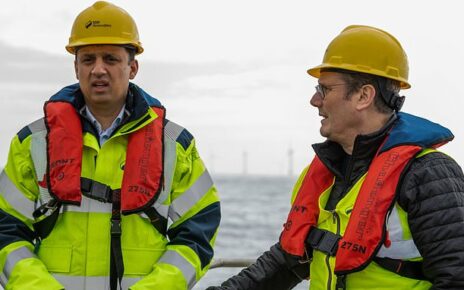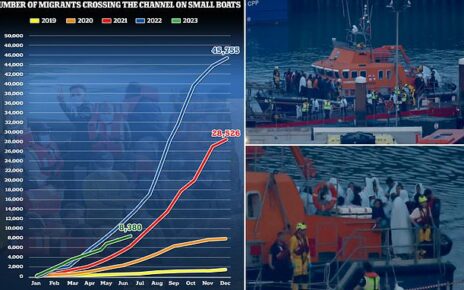LOCKED in a tiny air pocket at the bottom of the Atlantic Ocean, Harrison Okene could only pray as he listened to the horrifying sounds of fish feeding on the bodies of his dead colleagues.
Although he knew he could suffer a similar fate, the Nigerian chef was determined to stay alive after a wave sent their boat sinking to the depths of the ocean in 2013.


Harrison's terrifying ordeal is one of a handful of inspirational tales from over the years about those who found themselves lost at sea.
This week, Aussie Tim Shaddock became the latest real-life cast away to beat the odds, surviving on raw fish and rainwater for two months on a catamaran.
Here, we look at more stories of bravery, resilience, and determination.
Underwater hell
Harrison's vessel had set sail off the coast of Nigeria to secure a large oil tanker. Although they had to make their way through turbulent waters, they never expected the terrifying fate that was to come.
READ MORE FEATURES

I was shot in the face in deadliest US shooting… I’ll never forget sea of bodies

I had weird feeling about my dad… but truth was worse than I could have imagined
As the boat was smashed by a huge swell, it began to quickly sink. Harrison was thrown across a cabin, but was handed a lifeline when an air pocket formed, giving the then-29-year-old oxygen to breathe.
In a bid to survive, he stacked up mattresses to stay afloat but was almost certain he would succumb to his death.
Describing his horrific ordeal years later, he said: "I had access to nothing. I thought of my family, I thought of my mum, my brothers, my wife… there was no way to get to them and I knew I was going to die."
After spending several hours in the pitch-black chamber, he began to hear the chilling sound of fish tearing through the flesh of his dead colleagues.
Most read in The Sun

Mendy returns to football in shock transfer weeks after leaving Man City

Corrie star quits 26 years after joining – and his final scenes air tonight

Soap star Gemma Atkinson gives birth to baby boy with Strictly's Gorka

Tourists flee as masked man fires submachine gun at Costa del Sol restaurant
Speaking to 9News, he said: "I never knew if they were sharks or not, it was so dark. I heard them biting something. I was scared, I had to stay and keep watch to see if something would come my direction."
Sixty hours later and with no idea how long the air pocket would last, Harrison had given up all hopes of making it out alive – only to hear a knocking sound.

Miraculously, Harrison saw some light coming in through the deep. It was the flashlight of South African deep sea diver, Nico van Heerden, who along with a team had been sent to recover the bodies of the crew.
Harrison managed to gently tap on van Heerden's gear to alert him of his presence – the team couldn't believe that he had managed to spend nearly three days at the bottom of the ocean.
Speaking about the moment he was rescued, Harrison says: "When he came, I was just crying. He never knew what I was thinking.
"I was not afraid at that time. I had already decided if it's to be alive or dead, no problem. I had been ready to go [but] God heard my prayers."
Although Harrison later vowed never to return to the sea after suffering nightmares, he became a certified diver in 2015. To date, experts are still baffled by how he managed to stay alive for so long.
14-month ordeal


In November 2012, Jose Salvador Alvarenga set sail off the Mexican coast on a 30-hour shift of deep-sea fishing but soon came into difficulty following a ferocious storm which lasted five days.
Jose and his inexperienced partner, Ezequiel Cordoba, who he had just recruited for the trip, were left without food or water and no sense of direction.
The Salvadoran fisherman faced hunger and encounters with terrifying sharks as he hopelessly navigated the frightening Pacific Ocean.
He stayed alive by feasting on small birds, turtles, and jellyfish, which he had to scoop from the sea.
In an interview, after he was found, Jose said: "It burned the top part of my throat, but wasn’t so bad."
He added: "We had to drink our own urine after the storm. It wasn’t until a month later that we finally got some rainwater.”


While Jose knew his survival depended on his energy, Ezequiel, 23, was reluctant to eat raw birds and ended up starving to death.
Back in his home country, a search party sent out to find the men found no trace of them and gave up after a couple of days, citing poor visibility.
Although Jose contemplated killing himself, he decided against it due to his Christian faith. While trapped at sea, he saw several container ships but was unable to call for help.
He finally saw some land, which turned out to be a tiny islet at the corner of the Marshall Islands. Abandoning his boat on January 30, 2014, he swam to shore an incredible 14 months later, coming across a beach house owned by a couple.
When he was found, he was weak, struggled to walk without assistance, and had bushy hair. He was taken to a hospital for medical care and returned home to El Salvador for an emotional reunion with his family.
Disastrous adventure


In 1983, Tami Oldham Ashcraft set off from Tahiti with her British fiance Richard Sharp on an adventure to San Diego when she was 23.
The couple, however, ended up sailing right into Hurricane Raymond. After the full force of the wind struck, their boat stood no chance after being hit by 40-foot waves.
As the vessel was capsized, Tami was thrown against a cabin wall and knocked unconscious.
When she woke up 27 hours later, she realised that her beloved husband-to-be was lost at sea. The boat had been flooded and its radio and navigation system was no longer working.
Determined to survive, she made a makeshift sail from the ruins of the boat, designed a pump to drain the water, and set off towards Hawaii.
Surviving on a diet of canned food and peanut butter, she managed to last for 41 days before reaching Hilo, Hawaii.
Speaking about her terrifying experience, she said: "When I was out there, Richard was with me. I felt his presence, I talked to him constantly, I slept with his clothes around me.
"I heard his voice consoling me, encouraging me, and helping me to keep going in my darkest time."
Her story was turned into a 2018 film called Adrift, with Shailene Woodley playing her and Sam Claflin starring as Richard.
Desperate drift

In parts of the Pacific, people get around from one island to another by using small boats.
Although it was routine for three friends, Filo Filo, Etueni Nasau, and Samu Pelsa, they lost sight of the shore and became disoriented when they sailed off from Tokelau in 2010.
The teenagers, who were aged 14 and 15 at the time, drifted further away from land and into the ocean. The water and 20 coconuts they had brought with them had run out within two days.
For the next 48 days, they were forced to eat birds to survive.
After searches by local teams and New Zealand Air Force proved futile, their friends and family presumed they had died and arranged a memorial service for them, attended by 500 mourners.
Meanwhile, the boys got so desperate that they began drinking seawater – experts have noted that this is often a sign that death is imminent.
But after drifting over 500 miles, they were spotted by a fishing boat. Upon seeing their physical appearance, the sailor took them to Fiji for emergency care.
Tai Fredeicsen, who was in charge of the vessel that discovered them, said: "Their bones were protruding from underneath their skin. But mentally and spiritually, very high."
Solo sail

Steven Callahan always had a passion for boats and was determined to one day sail across the Atlantic Ocean.
That dream came to fruition in 1981, as he chartered his own vessel called the Napoleon Solo.
Departing from Newport on Rhode Island, he sailed to Bermuda and even made it to Cornwall before heading for Antigua.
The Napoleon Solo suffered irreparable damage, however, when it collided with a whale. Steven ended up abandoning it and carried on in an inflatable life raft that measured six feet.
After exhausting his limited food supplies, he survived by catching mahi-mahi as well as triggerfish and birds.
He had many close calls after coming face-to-face with sharks and punctures to the raft.
After 76 days at sea, he was picked up by fishermen drawn to birds flying over the raft.
He had lost a third of his weight and was covered in saltwater sores and in need of medical assistance. He spent six weeks recovering at a hospital.
Parts of Steven's story inspired the 2012 movie Life of Pi after he was consulted by director Ang Lee.
Survival Instinct


Rolando Omongos went missing while sailing on a tiny boat from the Philippines to Papua New Guinea aged 21.
His uncle had taken him along on a fishing trip in December 2017 but a storm separated the two men, leaving them fighting for their lives.
Following a month of hunger and exposure, Rolando's uncle died. He latched his body to the boat for a few days but later released it into the ocean after it began to smell.
Rolando was able to survive by drinking rainwater and eating moss growing at the hulk of his boat. Several boats passed him by each day, refusing to stop.
Nearly two months later, he was found by a Japanese fishing vessel – he incredibly weighed just 20kg, having lost 41kg.
Read More on The Sun

I got my lips tattooed but it went wrong…trolls say I look like a Flappy Bird

Tesco shoppers rush to buy must-have that’s scanning for £19.50 instead of £70
Speaking about his will to stay alive, he said: "I never lost hope. I was always praying. I told myself, at least one of us had to get back home.”
He added: "I cried non-stop when I was finally rescued. I was too weak to stand up and they had to carry me.”
Source: Read Full Article


